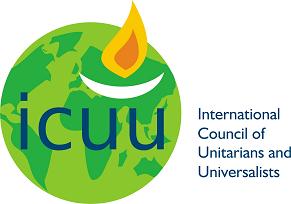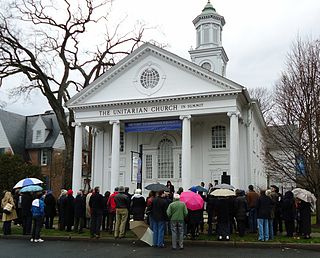
A flaming chalice is the most widely used symbol of Unitarianism and Unitarian Universalism (UUism) and the official logo of the Unitarian Universalist Association (UUA) and other Unitarian and UU churches and societies.

A flaming chalice is the most widely used symbol of Unitarianism and Unitarian Universalism (UUism) and the official logo of the Unitarian Universalist Association (UUA) and other Unitarian and UU churches and societies.
The symbol had its origins in a logo designed by Austrian refugee Hans Deutsch for the Unitarian Service Committee (USC) (now the Unitarian Universalist Service Committee) during World War II. According to USC director Charles Joy, Deutsch took his inspiration from the chalices of oil burned on ancient Greek and Roman altars. It became an underground symbol in occupied Europe during World War II for those assisting Unitarians, Jews, and other people to escape Nazi persecution. [1]
Living in Paris during the 1930s Deutsch drew critical cartoons of Adolf Hitler. When the Nazis invaded Paris in 1940, he abandoned all he had and fled to the South of France, then to Spain, and finally, with an altered passport, into Portugal. There, he met the Reverend Charles Joy, executive director of the Unitarian Service Committee (USC). The Service Committee was new, founded in Boston to assist Eastern Europeans, among them Unitarians as well as Jews, who needed to escape Nazi persecution. From his Lisbon headquarters, Joy oversaw a secret network of couriers and agents. [2]
After 1941, the flaming chalice symbol spread throughout Unitarianism in America and the rest of the world. This spread continued after Unitarians in North America merged with Universalists to form the Unitarian Universalist Association. The symbol gradually became more than a printed logo. By the 1960s, people like Fred Weideman of Dearborn, Michigan, were making flaming chalice jewelry. Some congregations began displaying the symbol in their worship spaces. At some point, three-dimensional chalices were made to be lit during worship services, but the origin(s) of this usage remains obscure.

The chalice is off center. This was taken from the Universalist symbol, the Off-Center Cross. The interpretation of the Off-Center Cross is that, while Universalism is based in Christianity, there is room for the Love and Wisdom of other religions.
The chalice symbol is often shown surrounded by two linked rings (see illustration). The two linked rings were based on the quote from the poet and life long Universalist Edwin Markham, "He drew a circle that shut me out—Heretic, rebel, a thing to flout. But Love and I had the wit to win: We drew a circle and took him in!" It also served as a symbol signifying the joining of Unitarianism and Universalism in 1961. In August 1962, the newsletter of the Midwestern Unitarian Universalist Association began using a chalice symbol drawn inside the two interlocking rings, as drawn by Betty King.
There is no orthodox interpretation of the flaming chalice symbol. In one interpretation, the chalice is a symbol of religious freedom from the impositions of doctrine by a hierarchy and open to participation by all; the flame is interpreted as a memorial to those throughout history who sacrificed their lives for the cause of religious liberty. In another interpretation, the flaming chalice resembles a cross, symbolic of the Christian roots of Unitarian and Universalism. [3]
Later, associations were made between this symbol and the Hussites religious sect. Czech reformer Jan Hus (1369–1415) began reading the Bible to his congregations in their native language, while the Catholic Church demanded that the Bible only be read in Latin. Also, during communion, the chalice was reserved for the clergy; the laity only received bread. When a church council condemned the practice of priests who were giving the chalice to their congregants, Hus refused to support the condemnation. After his execution by burning in 1415, followers of Hus adopted the "lay chalice" as an important symbol of their movement. [4]

Many Unitarian Universalist and Unitarian congregations and organizations feature flaming chalice symbolism on their signs, logos, and in their meeting places. Some congregations light a chalice displayed prominently in their worship space while saying opening words at the beginning of weekly worship services. The texts used during these "chalice lightings" vary; some congregations use a ritual formula while at others these words are spoken extemporaneously. [5]
Outside of weekly worship services, many small gatherings of Unitarian Universalists incorporate a lit chalice, often accompanied by readings, as a reminder of the religious nature of the gathering. Unitarian Universalists, Unitarians and Universalists might also display a flaming chalice on clothing, jewelry, their cars, or in their homes as a symbol of their faith, much as Christians display a cross or as Jews display a Star of David.
In keeping with the traditions of religious pluralism and individualism, there is no requirement, doctrinal or otherwise, that congregations or adherents use or acknowledge the flaming chalice as a religious symbol.
The flaming chalice has been approved by the United States Department of Veterans Affairs for use as the cemetery emblem for fallen veterans who identify themselves with the Unitarian or Unitarian Universalist faith tradition. [6]

The Canadian Unitarian Council (CUC) is a liberal religious association of Unitarian, Universalist, and Unitarian Universalist congregations in Canada. It was formed on May 14, 1961, initially to be the national organization for Canadians belonging to the Unitarian Universalist Association (UUA) which formed a day later on May 15, 1961. Between 1961 and 2002, almost all member congregations of the CUC were also members of the UUA and most services to congregations in Canada were provided by the UUA. However, in 2002, the CUC formally became a separate entity from the UUA, although the UUA continues to provide ministerial settlement services and remains the primary source for education and theological resources. Some Canadian congregations have continued to be members of both the CUC and the UUA, while most congregations are only members of the CUC.

The International Council of Unitarians and Universalists (ICUU) was an umbrella organization founded in 1995 comprising many Unitarian, Universalist, and Unitarian Universalist organizations. It was dissolved in 2021 along with the Unitarian Universalist Partner Church Council to make way for a new merged entity. Some groups represented only a few hundred people; while the largest, the Unitarian Universalist Association, had more than 160,000 members as of May 2011—including over 150,000 in the United States.

Unitarian Universalist Association (UUA) is a liberal religious association of Unitarian Universalist congregations. It was formed in 1961 by the consolidation of the American Unitarian Association and the Universalist Church of America Christian denominations with Unitarian and Universalist doctrines, respectively. However, modern Unitarian Universalists see themselves as a separate religion with its own beliefs and affinities. They define themselves as non-creedal, and draw wisdom from various religions and philosophies, including humanism, pantheism, Christianity, Hinduism, Buddhism, Taoism, Judaism, Islam, and Earth-centered spirituality. Thus, the UUA is a syncretistic religious group with liberal leanings.

Unitarian Universalism is a liberal religious movement characterized by a "free and responsible search for truth and meaning". Unitarian Universalists assert no creed, but instead are unified by their shared search for spiritual growth. Unitarian Universalists do not have an official, unified corpus of sacred texts. Unitarian Universalist congregations include many atheists, agnostics, deists, and theists; there are churches, fellowships, congregations, and societies around the world.

A chalice or goblet is a footed cup intended to hold a drink. In religious practice, a chalice is often used for drinking during a ceremony or may carry a certain symbolic meaning.

The Covenant of Unitarian Universalist Pagans is an independent affiliate of Unitarian Universalists who identify with the precepts of classical or contemporary Paganism: celebrating the sacred circle of life and guiding people to live in harmony with the rhythms of nature. CUUPS members foster the development of "liturgical materials based on earth- and nature-centered religious and spiritual perspectives" as well as encourage "greater use of music, dance, visual arts, poetry, story, and creative ritual in Unitarian Universalist worship and celebration." Many members of CUUPS embrace the cycle of seasons and beauty of all life forms found in nature. Unlike many mainline religious sects, Unitarian Universalists and Pagans both value the "sacredness in the present world rather than on an afterlife." CUUPS is a community open to all Unitarian Universalist members and those who support the tenets.

A variety of religious emblems programs are used by the Boy Scouts of America (BSA) to encourage youth to learn about their faith and to recognize adults who provide significant service to youth in a religious environment. These religious programs are created, administered and awarded by the various religious groups, not the BSA, but each program must be recognized by the BSA.
Flower Communion, also known as Flower Ceremony, Flower Festival, or Flower Celebration, is a ritual service common in Unitarian Universalism, though the specific practices vary between congregations. It is usually held on the last Sunday of worship in late May or June, as some congregations recess from holding services during the summer. Some congregations hold the ceremony earlier in the spring, sometimes coinciding with Mother's Day or Easter.
The Church of the Larger Fellowship (CLF) provides a ministry to isolated Unitarian Universalists (UUs). Its mission also includes growing Unitarian Universalism by supporting small congregations and new UUs around the world. The CLF also offers resources to Unitarian Universalists active in local congregations.

Unitarian Universalism, as practiced by the Unitarian Universalist Association (UUA), and the Canadian Unitarian Council (CUC), is a non-Creedal and Liberal theological tradition and an LGBTQ affirming denomination.

All Souls Unitarian Church is a Unitarian Universalist (UU) church in Tulsa, Oklahoma. It is one of the largest UU congregations in the world.
The Eno River Unitarian Universalist Fellowship (ERUUF) is a Unitarian Universalist (UU) congregation located in Durham, North Carolina. In 2018, over seven hundred people were members of ERUUF, making it the largest UU congregation in NC and one of the largest in the UUA.

Beacon Unitarian Universalist Congregation in Summit is a Unitarian Universalist ("UU") congregation in Summit, New Jersey, formally organized in 1908 as The Unitarian Church in Summit. It is active in social justice initiatives and received the Unitarian Universalist Service Committee Social Justice Award in 2010. It has also been recognized as an outstanding UU congregation by various UU groups. In 2016, Robin Tanner became the Minister of Worship and Outreach.

The Unitarian Universalist Church of Buffalo is an historic church complex located at 695 Elmwood Avenue, in Buffalo, New York. The building was designed by architect Edward Austin Kent in 1906. Kent died in 1912 aboard the RMS Titanic and a memorial plaque is located in the church honoring him.
Chalica is a holiday celebrated by some Unitarian Universalists. It traditionally begins on the first Monday in December and lasts seven days, though a seven-week variant beginning in January is also observed.

The First Universalist Church of Atlanta, organized in 1895, re-established a Universalist presence in Atlanta, Georgia. Initial missionary efforts in 1879 were short-lived and failed to establish a permanent presence in the city. With the explicit assistance the Young People's Christian Union, this second missionary effort enabled the Universalists to sustain their presence and construct a church building on East Harris in 1900. The Universalists occupied the church until 1918 when they merged with Atlanta's Unitarians.

Northwest Unitarian Universalist Congregation (Northwest) was organized in 1969. The organization of Northwest was the result of action taken by the Unitarian Universalist Congregation of Atlanta (UUCA) to establish a new congregation in the northwest suburbs of Atlanta.
Annie Bizzell Jordan Willis was an American religious educator and integrationist of the Universalist and later Unitarian Universalist faith traditions. She was the daughter of Rev. Joseph Fletcher Jordan, the first African American Universalist minister. She became a teacher and the superintendent of Suffolk Normal Training School (SNTS) and Jordan Neighborhood House. For decades, she taught and supported hundreds of children and their families, regardless of the varying degrees of assistance from her religious denomination. Her life and work are examples of 20th century anti-racism in the United States and the Unitarian Universalist religious faith. Some of her students include trauma surgeon L.D. Britt, Suffolk's vice mayor and activist Moses Riddick, and Suffolk Circuit Court Deputy Clerk Eula Williams, among many others.
William "Bill" Russell Murry was an American humanist, author, Unitarian Universalist minister, and former President of Meadville Lombard Theological School.